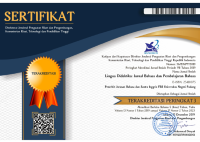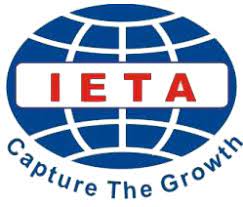Cohesive Devices in Children Literature and Adult Literature
 ), Gede Irwandika(2),
), Gede Irwandika(2), (1) Universitas Mahasaraswati Denpasar
(2) Universitas Mahasaraswati Denpasar
 Corresponding Author
Corresponding Author
Copyright (c) 2024 Lingua Didaktika: Jurnal Bahasa dan Pembelajaran Bahasa
DOI : https://doi.org/10.24036/ld.v18i2.125071
Full Text:
 Language : en
Language : en
Abstract
Cohesive devices were crucial in maintaining coherence and facilitating effective communication in written texts. They served as linguistic tools that connected different parts of the text and ensured its logical flow. The results of the data analysis were presented based on the types of cohesive devices according to Halliday & Hassan (1976). This paper focuses on cohesive devices in text, examining how they are realized in two different genres, specifically adult and children’s literature. The writer explored the use of cohesive devices in adult and children’s literature, comparing the similarities and differences between these two genres. Personal reference remained the most dominant type of cohesive device used. However, unlike the reference, neither children’s nor adult literature showed any substitutions. There were differences in the conjunctions between children’s and adult literature. In children’s literature, simple conjunctions were used. On the other hand, in adult literature, several types of conjunctions were quite specific. In terms of lexical cohesion, there was no significant difference compared to grammatical cohesion. In conclusion, in both genres, the use of cohesive devices played an important role, but the level of difficulty or complexity differed, considering the different target readers.
Keywords
References
Abbott, H. Porter. (2008). The Cambridge Introduction To Narrative. Cambridge University Press.
Aqmarina, Asprilla. (2020). The Exploration Of Cohesive Devices In Synopsis Writings Produced By English Study Program Students Of Universitas Gadjah Mada. Salee: Study Of Applied Linguistics And English Education. 1. 51-66. 10.35961/Salee.V 1i01.73
Astariani, P.S.P. (2020). The Analysis of Cohesive Devices Found in Good-Bye. Udayana Journal of Social Sciences and Humanities, 4 (1), 41 – 46
Ayomi, P.N., & Pratama, K.D. (2018). Cohesive Devices In Journalistic Articles And Children Story. SPHOTA, 10 (1), 36 – 45
Ayomi, Putu. Nur. (2016). Introduction to Discourse Analysis. Stiba Saraswati Denpasar
Brown, L., & Green, P. (2018). Conjunction Usage in Different Literary Genres" Journal of Linguistic Research.
Chanyoo, N. (2018). Cohesive devices and academic writing quality of Thai undergraduate students. Journal of Language Teaching and Research, 9 (5),994-1001.
https://doi.org/10.17507/jltr.0905.13
Hadi, M.Z.P. (2014). The Comparison of Cohesive Devices in English and Indonesian Descriptive texts Written by Undergraduared Students. Thesis for Master Degree of English Language Education in Semarang State University.
Halliday, M.A.K & Hasan, Ruqaiya. (1976). Cohesion in English. London New York : Longman.
Halliday, M.A.K & Hasan, Ruqaiya. (1985). Language, Context, and Text : Aspect of Language in a Social Semiotic Perspective. Victoria: Deakin University.
Hidayat, A. (2016). An Analysis of Grammatical Cohesive Device of the Short Story the Little Match Girl by Hans Christian Andersen 2016/2017. English Education: Jurnal Tadris Bahasa Inggris, 9 (2), 232 – 244
Islami, Kifti & Saleh, Mursid & Bharati, Dwi. (2022). The Use of Cohesive Devices in Descriptive Text by English Training Participants at PST”. English Education Journal. 12. 95-102. 10.15294/eej.v12i1.49052.
Jayanti, Dwi., & Hidayat, D.N. (2021). Grammatical Cohesive Devices in Reading Text: A Discourse Analysis of English Test for Junior High School. Journal of English Teaching Adi Buana, 6 (1), 1 – 16
Jones, A. (2017). Ellipsis in Adult and Children’s Literature. International Journal of Literary Analysis.
Kheirkhah, Fateme.(2016). Use of Cohesive Devices in Children and Regular Literature: Conjunctions and Lexical Cohesion. International Journal of Comparative Literature & Translation Studies, 4 (4), 12-23
Kuswoyo, et al (2020). Cohesive Conjunctions and and so as Discourse Strategies in English Native and Non-Native Engineering Lecturers: A Corpus-Based Study. 29. 2322-2335.
Liang-Itsara, Aphiwit. (2018). Cohesive Devices and Academic Writing Quality of Thai Undergraduate Students. Journal of Language Teaching and Research. 9. 994. 10.17507/jltr.0905.13.
Louwerse, M. M., et.al. 2004. Variation in Language and Cohesion across Written and Spoken Registers. InK. Forbus, D. Gentner & T. Regier (Eds.), Proceedings of the 26th Annual Meeting of the Cognitive Science Society (pp.843-848). Mahwah, NJ:Erlbaum.
Moini, Mohammad.Raouf. (2016). Use of Cohesive Devices in Children and Regular Literature: Conjunctions and Lexical Cohesion. International Journal of Comparative Literature & Translation Studies, 4 (4), 12 – 20
Nodelman, Perry. (2008). The Pleasures of Children’s Literature. Oxford University Press
Paltridge, B. (2012). Discourse Analysis: An Introduction (2nd ed.). London: Bloomsbury.
Pertiwi, Y. W. (2022). Communication and social skills of preschool children as affected by their mother’s employment status. International Journal of Multicultural and Multireligious Understanding, 9 (10), 4051. https://doi.org/10.18415/ijmmu.v9i10.4051
Saputra, Andri & Hakim, M. (2020). The Usage of Cohesive Devices by High-Achieving EFL Students in Writing Argumentative Essays. Indonesian TESOL Journal. 2. 42-58. 10.24256/itj.v2i1.1227.
Setiawan, F., & Taiman, T. (2021). Cohesion and coherence in written texts of health medical laboratory students. Indonesian EFL Journal, 7(1), 59-68.
Swales, J. (1990). Genre Analysis: English in Academic and Research Settings. Cambridge: Cambridge University Press.
Tanskanen, S. K. (2006). Collaborating towards Coherence: Lexical Cohesion in English Discourse. John Benjamins Publishing.
Todorov, Tzvetan ([1971] 1977). The Poetics of Prose. Ithaca: Cornell UP.
Ulfa, Maria. (2016). An Analysis Of Lexical Cohesion In Narrative Text Three Children Storybooks Of “Oliver And Jumpy” By Werner Stejskal. Thesis for Bachelor’s Degree of English Language Teaching Department Tarbiyah And Teacher Training Faculty Syekh Nurjati State Islamic Institute Cirebon.
Wang, Y., & Zhang, H. (2019). The Role of Conjunctions in Academic Writing: A Corpus-Based Study. Journal of English for Academic Purposes.
Warna, Dewi & Wijaya, Beni & Sartika, Eka & Riznanda, Winny. (2019). Cohesive Devices Used in Argumentative Essays of Undergraduate EFL Students in Indonesia. ENGLISH FRANCA : Academic Journal of English Language and Education. 3. 125. 10.29240/ef.v3i02.1164.
 Article Metrics
Article Metrics
 Abstract Views : 101 times
Abstract Views : 101 times
 PDF Downloaded : 52 times
PDF Downloaded : 52 times
Refbacks
- There are currently no refbacks.
Copyright (c) 2024 Lingua Didaktika: Jurnal Bahasa dan Pembelajaran Bahasa

This work is licensed under a Creative Commons Attribution-NonCommercial 4.0 International License.









